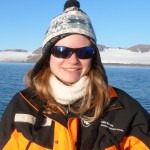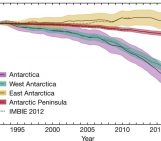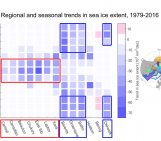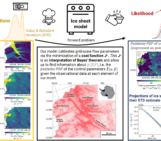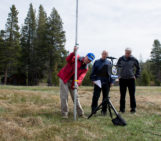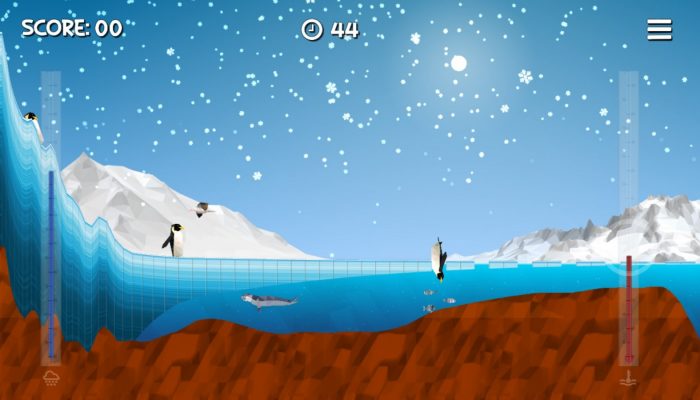
Portraying ice sheets and shelves to the general public can be tricky. They are in remote locations, meaning the majority of people will never have seen them. They also change over timescales that are often hard to represent without showing dramatic images of more unusual events such as the collapse of the Larsen B Ice Shelf. However, an app launched in the summer at the SCAR (Scientific Committee for Antarctic Research) Open Science Conference in Kuala Lumpur set out to change this through a game. Developed by Anne Le Brocq from the University of Exeter, this game is aptly named – Ice Flows!
The game in a nutshell!
Ice Flows is a game that allows the player to control various variables of an ice shelf (floating portion of an ice sheet) environment, such as ocean temperature and snowfall, and see the changes that these cause. For example, increasing the amount of snowfall increases the ice thickness but increasing the ocean temperature causes thinning of the ice shelf. The aim of the game is to help penguins feed by altering the variables to create ice shelf conditions which give them access to the ocean. Although the game is based around penguins, importantly, it is changing the ice shelf environment that the player controls, this allows a player to investigate how changing environmental conditions affect the ice. Our Image of the week shows a still from the game, where the player has created ice conditions which allow the penguins to dive down and catch fish.
What is the educational message?
The polar regions are constantly changing and assigning these changes to either natural cycles or anthropogenic (human induced) climate change can be tricky. Ice shelves tend to only hit the news when large changes happen, such as the recent development of the Larsen C rift which is thought to be unrelated to the warming climate of the region but may still have catastrophic consequences for the ice shelf. Understanding that changes like these can sometimes be part of a natural process can seem conflicting with the many stories about changes caused by warming. That’s why ice flows is a great way to demonstrate the ways in which ice shelves can change and the various factors that can lead to these changes. And the bonus chance to do this with penguins is never going to be a bad thing!
The game allows players to visualise the transformation of ice sheet to ice shelf to iceberg. This is an especially important educational point given the confusing ways that various types of ice can be portrayed by the media; reports, even if factually correct, will often jump from sea ice to ice shelves and back (see this example). It is also common for reports to cloud the climate change narrative by connecting processes thought to be due to natural causes (such as the Larsen C rift) to a warming climate (such as this piece). This confusion is something I often see reflected in people’s understanding of the cryosphere. In my own outreach work I start by explicitly explaining the difference between ice shelves and sea ice (my work is based on ice shelves). Even so, I can usually guarantee that many people will ask me questions about sea ice at the end of my talk.

Xue Long the Snow Dragon Penguin [Credit: Ice Flows game ]
Despite the messages that it is trying to convey, the app doesn’t come across as pushing the educational side too much. There is plenty of information available but the game also has genuinely fun elements. For example, you can earn rewards and save these to upgrade your penguins to some extravagant characters (my favourite has to be Xue Long – the snow dragon penguin!) Although the focus may be drawn towards catching the fish for the penguins while you’re actually playing, it would be hard for anyone to play the game and walk away without gaining an understanding of the basic structure of an ice shelf and how various changing environmental factors can affect it.
Developing the game…
The game was developed by Anne Le Broq in collaboration with games developers Inhouse Visual and Questionable Quality, using funding from the Natural Environment Research Council. Of course, many scientific researchers were also involved to ensure that the game was as scientifically accurate as possible whilst still remaining fun to play.
A key challenge in developing the game was modelling the ice flow. In order to be used in the app, the ice flow model needed to represent scientific understanding as well as being reactive enough to allow the game to be playable. This required some compromise, as one of the scientists involved in the development, Steph Cornford (CPOM, University of Bristol), explains on the CPOM Blog:
On one hand, we wanted the model to reflect contemporary understanding well enough for students to learn about ice sheets, ice shelves, and Antarctica in particular. On the other, the game had to be playable, so that any calculations needed to be carried out quickly enough that the animation appeared smooth, and changing any of the parameters (for example, the accumulation rate) had to lead to a new steady state within seconds, to make the link between cause and effect clear.
— Steph Cornford
The resulting model works really well, creating a fun, challenging and educational game! See for yourself by downloading the free to play game from your app store, or online at www.iceflowsgame.com!
Further reading
- Find out more about the game on the University of Exeter website or visit the game’s own website here.
- You can read in more detail about Steph’s modelling here.
Edited by Emma Smith
Sammie Buzzard has recently submitted her PhD thesis where she has developed a model of ice shelf surface melt, focusing on the Larsen C Ice Shelf. She is based at the Centre for Polar Observation and Modelling within the University of Reading’s Department of Meteorology. She blogs about her work and PhD life in general at https://iceandicing.wordpress.com/ and tweets as @treacherousbuzz.

